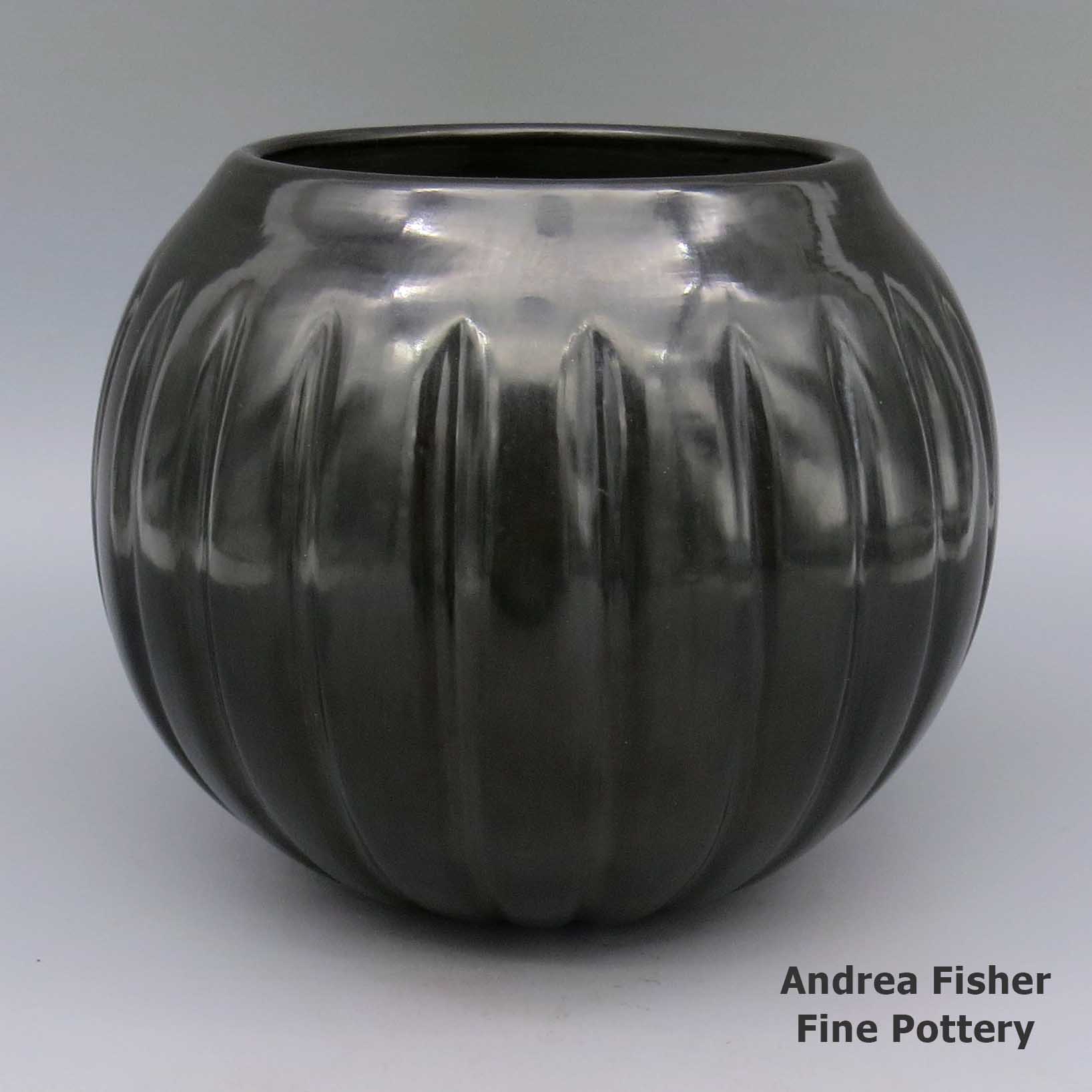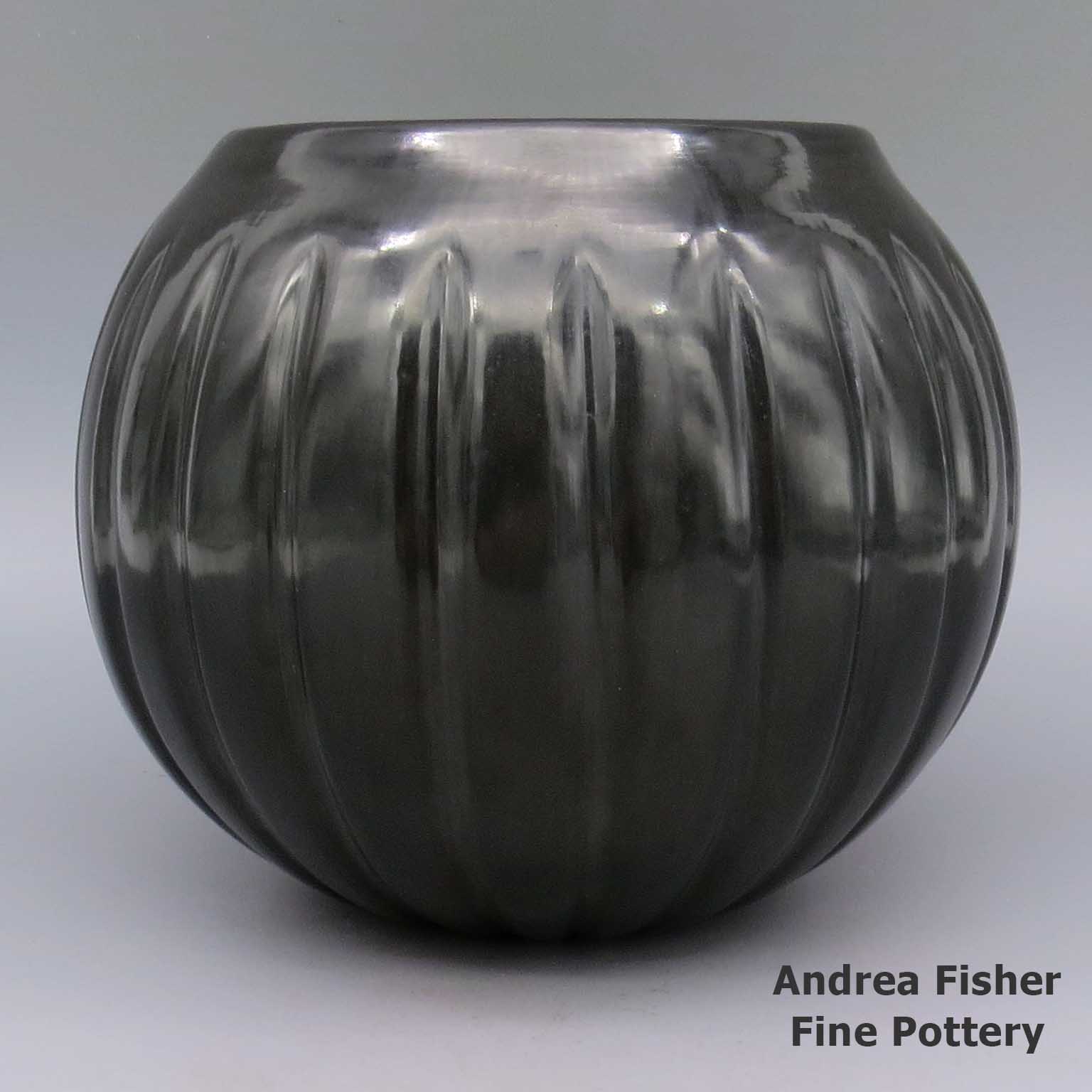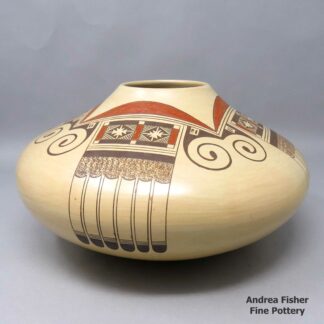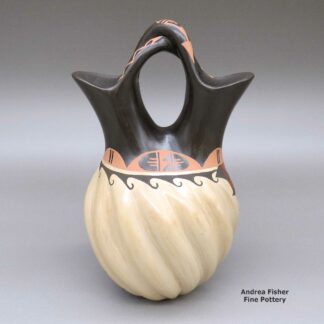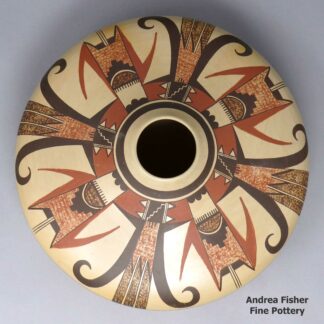| Dimensions | 8 × 8 × 6.75 in |
|---|---|
| Condition of Piece | Very good |
| Signature | Tina Garcia San Juan Santa Clara |
Tina Garcia, zzsc2h332, Black melon jar with 24 ribs
$1,600.00
A black melon jar sectioned with 24 ribs
In stock
Brand
Garcia, Tina
Tina began producing pottery herself at the age of 11 and by the age of 23 she was a full-time potter.
After studying the collections at the School for American Research in Santa Fe she decided to make mostly traditional, classic shapes without the carving so prevalent among contemporary Santa Clara pottery. Most of Tina's work is undecorated but she did occasionally use a bear paw imprint, one of the symbols of Santa Clara Pueblo. Tina is known for her finely polished red and black large, classic jars, water jars and for her bowls.
Tina's work has been shown in many venues and exhibitions, from New York to Pittsburgh to Santa Fe and Phoenix. She earned numerous First and Second Place ribbons at the Santa Fe Indian Market and at the Eight Northern Pueblos Arts & Crafts show.
Tina's sister, Virginia Garcia, and her brother, Greg Garcia, are also award-earning potters. Tina passed on in 2005.
A Short History of Santa Clara Pueblo

Santa Clara Pueblo straddles the Rio Grande about 25 miles north of Santa Fe. Of all the pueblos, Santa Clara has the largest number of potters.
The ancestral roots of the Santa Clara people have been traced to ancient pueblos in the Mesa Verde region in southwestern Colorado. When the weather in that area began to get dry between about 1100 and 1300 CE, some of the people migrated to the Chama River Valley and constructed Poshuouinge (about 3 miles south of what is now Abiquiu on the edge of the mesa above the Chama River). Eventually reaching two and three stories high with up to 700 rooms on the ground floor, Poshuouinge was inhabited from about 1375 CE to about 1475 CE.
Drought then again forced the people to move. One group of the people went to the area of Puyé (along Santa Clara Canyon, cut into the eastern slopes of the Pajarito Plateau of the Jemez Mountains). Another group went south of there to what we now call Tsankawi. A third group went a bit to the north, following the Rio Chama down to where it met the Rio Grande and founded Ohkay Owingeh on the northwest side of that confluence.
Beginning around 1580, another drought forced the residents of the Puyé area to relocate closer to the Rio Grande. There, near the point where Santa Clara Creek merged into the Rio Grande, they founded what we now know as Santa Clara Pueblo. Ohkay Owingeh was to the north on the other side of the Rio Chama. That same dry spell forced the people down the hill from Tsankawi to the Rio Grande where they founded San Ildefonso Pueblo to the south of Santa Clara, on the other side of Black Mesa.
In 1598 Spanish colonists from nearby Yunqué (the seat of Spanish government near the renamed "San Juan de los Caballeros" Pueblo) brought the first missionaries to Santa Clara. That led to the first mission church being built around 1622. However, the Santa Clarans chafed under the weight of Spanish rule like the other pueblos did and were in the forefront of the Pueblo Revolt of 1680. One pueblo resident, a mixed black and Tewa man named Domingo Naranjo, was one of the rebellion's ringleaders.
When Don Diego de Vargas came back to the area in 1694, he found most of the Santa Clarans were set up on top of nearby Black Mesa (with the people of San Ildefonso, Pojoaque, Tesuque and Nambé). An extended siege didn't subdue them but eventually, the two sides negotiated a treaty and the people returned to their pueblos. However, successive invasions and occupations by northern Europeans took their toll on the pueblos over the next 250 years. The Spanish flu pandemic in 1918 almost wiped them out.
Today, Santa Clara Pueblo is home to as many as 2,600 people and they comprise probably the largest per capita number of artists of any North American tribe (estimates of the number of potters run as high as 1-in-4 residents).
For more info:Pueblos of the Rio Grande, Daniel Gibson, ISBN-13:978-1-887896-26-9, Rio Nuevo Publishers, 2001
Upper photo courtesy of Einar Kvaran, Creative Commons Attribution-Share Alike 3.0 Unported License
About Jars
The jar is a basic utilitarian shape, a container generally for cooking food, storing grain or for carrying and storing water. The jar's outer surface is a canvas where potters have been expressing their religious visions and stories for centuries.
In Sinagua pueblos (in northern Arizona), the people made very large jars and buried them up to their openings in the floors of the hidden-most rooms in their pueblo. They kept those jars filled with water but also kept smaller jars of meat and other perishables inside those jars in the water. It's a form of refrigeration still in use among indigenous people around the world.
Where bowls tend to be low, wide and with large openings, jars tend to be more globular: taller, less wide and with smaller openings.
For a potter looking at decorating her piece, bowls are often decorated inside and out while most jars are decorated only on the outside. Jars have a natural continuity to their design surface where bowls have a natural break at the rim, effectively yielding two design surfaces on which separate or complimentary stories can be told.
Before the mid-1800s, storage jars tended to be quite large. Cooking jars and water jars varied in size depending on how many people they were designed to serve. Then came American traders with enameled metal cookware, ceramic dishes and metal eating utensils...Some pueblos embraced those traders immediately while others took several generations to let them and their innovations in. Either way, opening those doors led to the virtual collapse of utilitarian pottery-making in most pueblos by the early 1900s.
In the 1920s there was a marked shift away from the machinations of individual traders and more toward marketing Native American pottery as an artform. Maria Martinez was becoming known through her exhibitions at various major industrial fairs around the country and Nampeyo of Hano was demonstrating her art for the Fred Harvey Company at the Grand Canyon. The first few years of the Santa Fe Indian Market helped to solidify that movement and propel it forward. It took another couple generations of artists to open other venues for their art across the country and turn Native American art into the phenomenon it has become.
Today's jars are artwork, not at all for utilitarian purposes, and their shapes, sizes and decorations have evolved to reflect that shift.
About the Melon Jar
The lives of the various centuries-old pueblo cultures have been based on the cycles of agriculture, specifically the growing and harvesting cycles of the "three sisters": maize, squash and beans. Melon jars are specifically about emulating the different forms of the squash that they cultivated.
Most melon jars are coiled round first, then carved and polished into their final shapes. Helen Shupla (of Santa Clara) perfected a method of forming a melon shape by coiling the jar, smoothing it, then pushing out ribs from the inside. She taught that method to her daughter, Jeannie, and to her Hopi son-in-law, Alton Komalestewa.
After Helen and Jeannie died, Alton got together with Jake Koopee and Jake showed him how he could work the same way using Hopi clay. Jake made three melon jars to show Alton, and they were the only melon jars Jake ever made.
Some Hopi potters still make melon jars and bowls, as do some potters at Jemez, San Ildefonso, Santa Clara, Ohkay Owingeh and Taos.
Gutierrez Family Tree - Santa Clara Pueblo
Disclaimer: This "family tree" is a best effort on our part to determine who the potters are in this family and arrange them in a generational order. The general information available is questionable so we have tried to show each of these diagrams to living members of each family to get their input and approval, too. This diagram is subject to change should we get better info.
- Tonita Gutierrez (1859-aft 1934) and Jose Domingo Gutierrez (1844-before 1931)
- Lela (1895-1966) & Van (Evangelio) Gutierrez (1885-1956)
- Luther Gutierrez (1911-1987) & Lupita Naranjo
- Paul Gutierrez & Dorothy Gutierrez (Dineh)
- Gary Gutierrez
- Paul Gutierrez Jr. (1966-)
- Pauline Gutierrez Naranjo (1931-) & Frank Naranjo
- Stephanie Naranjo (1960-)
- Paul Gutierrez & Dorothy Gutierrez (Dineh)
- Margaret Rose Gutierrez (1936-2018)
- Luther Gutierrez (1911-1987) & Lupita Naranjo
- Severa Gutierrez Tafoya (1890-1973) and Cleto Tafoya
- Angela Tafoya Baca (1927-2014) & Antonio Baca
- Alvin Baca (1966-)
- Daryl Baca (1961-)
- David Baca (1951-)
- Leona Baca (1958-)
- Epimenia (Mela) Tafoya (1920-1962) & Robert Nichols
- Robert Cleto Nichols (1961-) & Miana Pablito (Zuni)
- Lydia Tafoya (1923-1975) & Santiago Garcia (San Juan/Ohkay Owingeh)
- Greg Garcia (1961-2010)
- Tina Garcia (1957-2005)
- Virginia Garcia (1963-)
- Maria (Mary Agnes) Tafoya (1925-1983) & Mosimino Tafoya
- Stephanie Tafoya Fuentes (1963-) & Lorenzo Fuentes
- Alita Povijua (1957-)
- Kathy Silva (1947-)
- Gwen Tafoya
- Wanda Tafoya (1950-)
- Eric Tafoya (1969-)
- Lawrence Tafoya (1968-)
- Mary Agnes Talache (1981-)
- Charlene Victoria Talache (1986-)
- Tonita (1930-) & Paul Tafoya
- Paul Speckled Rock (1952-2017)
- Adam Speckled Rock (1972-)
- Kenneth Tafoya (1953-)
- Ray Tafoya (1956-1995) & Emily (Suazo) Tafoya
- Jennifer (Tafoya) Moquino (1977-) & Michael Moquino
- Leslie Tafoya
- Paul Speckled Rock (1952-2017)
- Angela Tafoya Baca (1927-2014) & Antonio Baca
